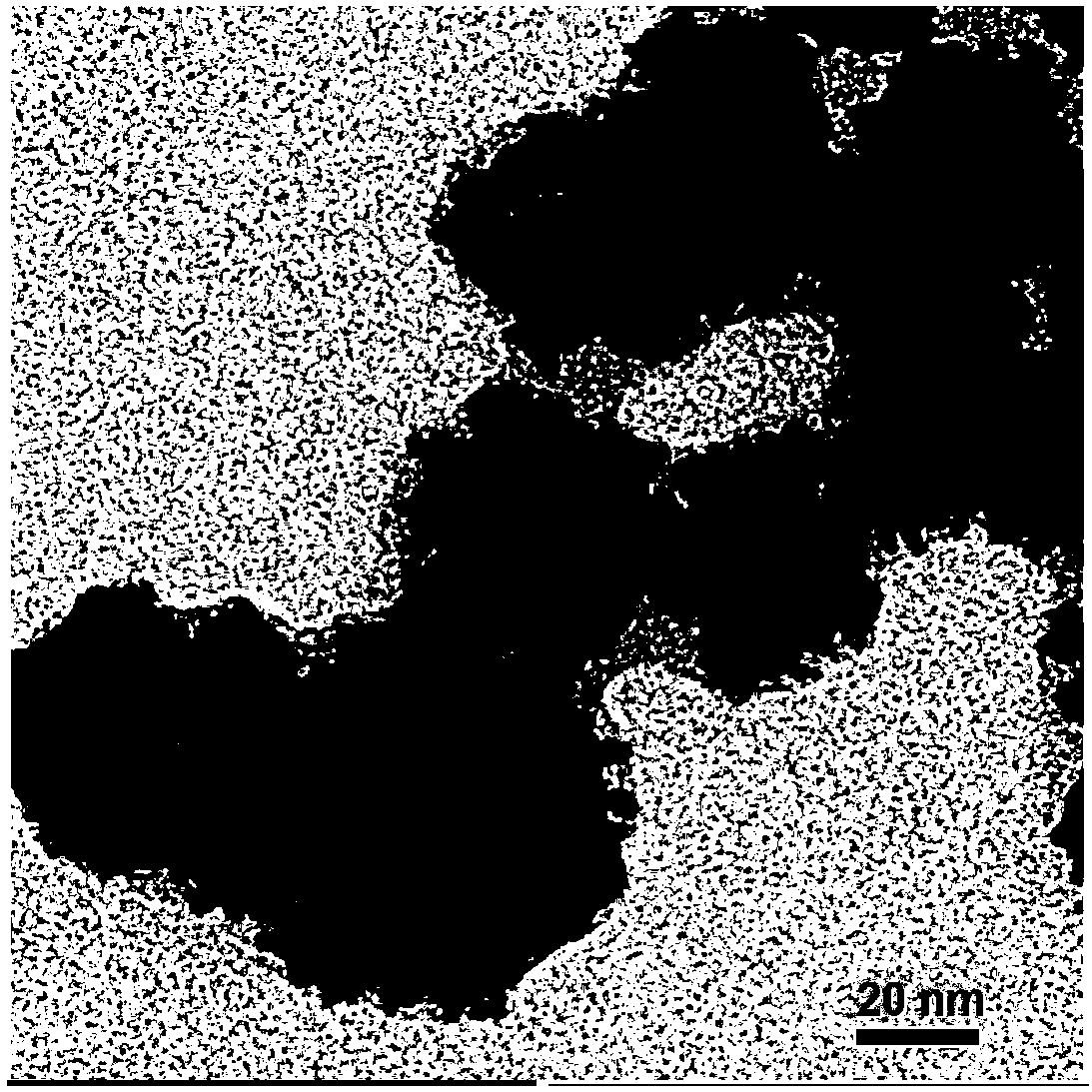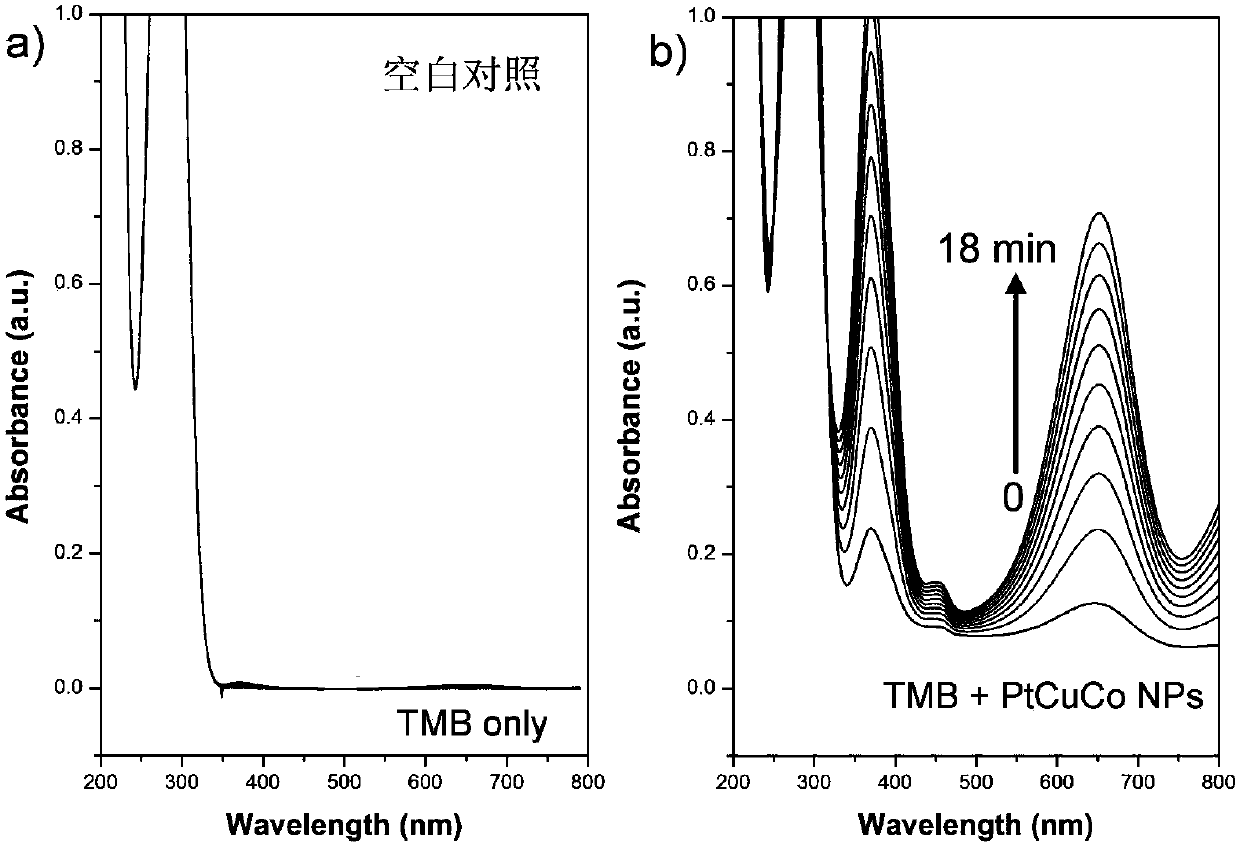Hollow platinum-copper-cobalt ternary alloy nanoparticle mimic enzyme and preparation and application thereof
A nanoparticle and cobalt alloy technology, which is applied in the field of catalytic materials and analytical chemistry, can solve the problems of complex synthesis and purification steps, limit the application of natural enzymes, inactivation and denaturation, etc., and achieve high chemical stability, high repeatability, and non-toxic reagents Effect
- Summary
- Abstract
- Description
- Claims
- Application Information
AI Technical Summary
Problems solved by technology
Method used
Image
Examples
Embodiment 1
[0035] Preparation of platinum-copper-cobalt alloy nanoparticle mimic enzyme:
[0036] co 3 o 4 Preparation of granules: Put 0.6g cobalt acetate, 2.2g CTAB, 60ml ethylene glycol, and 11ml water in a 100ml beaker, stir the mixture for 20 minutes, then transfer the mixture to a 100ml polytetrafluoroethylene reactor for 48 hours at 180°C . The obtained black precipitate was washed twice with water and ethanol respectively, and then vacuum-dried at 60°C to obtain a black solid powder, which was calcined at 320°C for 10 minutes to obtain black Co 3 o 4 particles.
[0037] Take PVP, Glycine, g Co 3 o 4 、K 2 PtCl 4 , CuCl 2 、NiCl 2 , mixed with deionized water and ultrasonically dispersed for 5 minutes, and the mixed solution was transferred to a 20mL reactor at 200°C for 6 hours. After the reaction, the product was washed twice with ethanol and water respectively, and centrifuged at 10,000 rpm / min for 15-20 min. and finally dispersing the obtained alloy nanoparticles int...
Embodiment 2
[0046] The method for detecting glucose concentration, the process is as follows:
[0047] 1) Mix the platinum-copper-cobalt alloy nanoparticle mimetic enzyme prepared in Example 1 with the TMB solution, and record the absorbance of the characteristic absorption peak at 650 nm using the absorption curve of the solution with an ultraviolet-visible absorption spectrometer.
[0048] 2) Take 3.0ml of deionized water, add 200μl of 1mg / ml glucose oxidase (GOX), 0-400μl of 0.1M glucose aqueous solution to it in sequence, and then add 20μl of 20mM 3,3',5, 5'-Tetramethylbenzidine (TMB), 5 μl 1.3mM platinum-copper-cobalt alloy nanoparticles simulated enzyme solution, then mix the above solution evenly, place it at room temperature (25°C) for 15 minutes, and use a UV-visible spectrophotometer to detect Absorbance values. Draw a working curve by plotting the detected absorbance value at 650nm with the added glucose concentration.
[0049] Colorimetric detection of glucose based on plati...
Embodiment 3
[0053] The method for detecting the concentration of the hanging white block is as follows:
[0054] 1) Mix the platinum-copper-cobalt alloy nanoparticle imitative enzyme prepared in Example 2 with hydrogen peroxide and TMB solution, and use a UV-visible absorption spectrometer to scan the kinetic mode to record the absorption curve of the solution every 2 minutes, and record the characteristic absorption at 650nm The absorbance of the peak is used to monitor and calculate the oxidation rate of TMB through the change of absorbance with time.
[0055] 2) After mixing the platinum-copper-cobalt alloy nanoparticle mimic enzyme prepared in Example 2 with hydrogen peroxide and TMB solution, add 0.3, 0.5, 1.0, 2.0, 5.0, 10.0, 15.0, 20.0, 30.0, 50.0, 60.0 , 80.0, and 100 μM of the hanging white block solution, use the UV-visible absorption spectrometer to scan the kinetic mode to record the absorption curve of the solution every 2 minutes, record the absorbance of the characteristic ...
PUM
 Login to View More
Login to View More Abstract
Description
Claims
Application Information
 Login to View More
Login to View More - R&D
- Intellectual Property
- Life Sciences
- Materials
- Tech Scout
- Unparalleled Data Quality
- Higher Quality Content
- 60% Fewer Hallucinations
Browse by: Latest US Patents, China's latest patents, Technical Efficacy Thesaurus, Application Domain, Technology Topic, Popular Technical Reports.
© 2025 PatSnap. All rights reserved.Legal|Privacy policy|Modern Slavery Act Transparency Statement|Sitemap|About US| Contact US: help@patsnap.com



